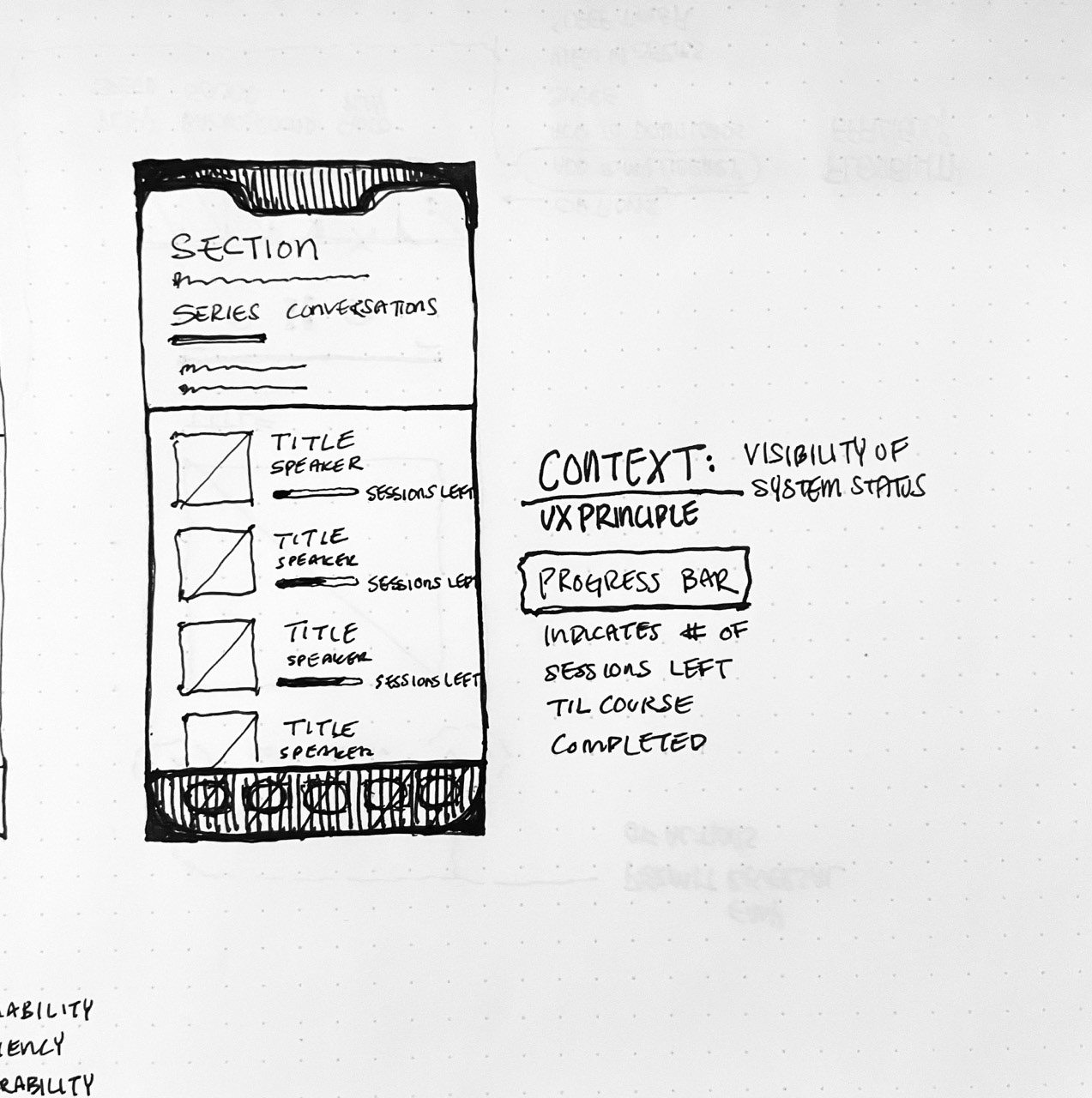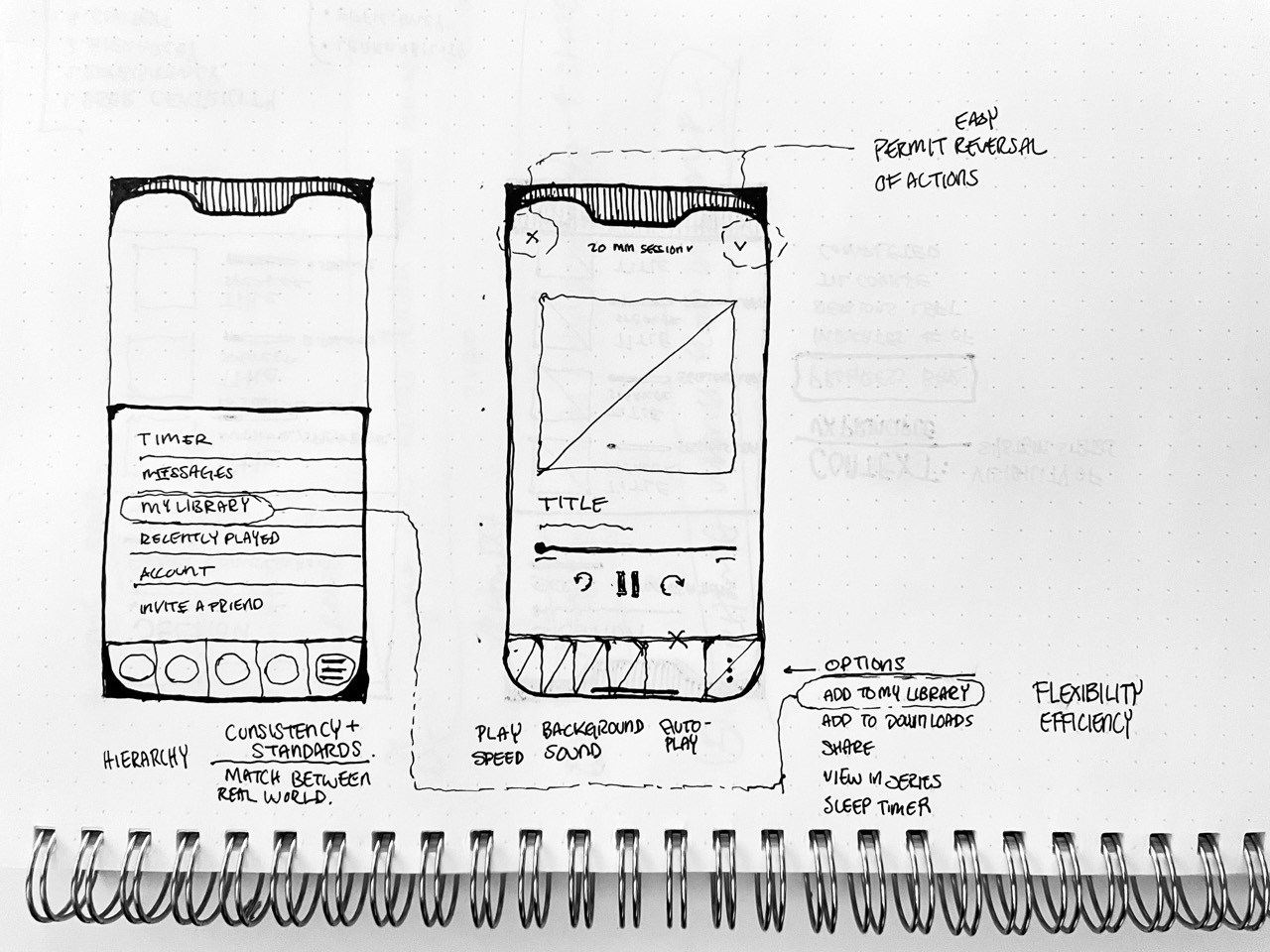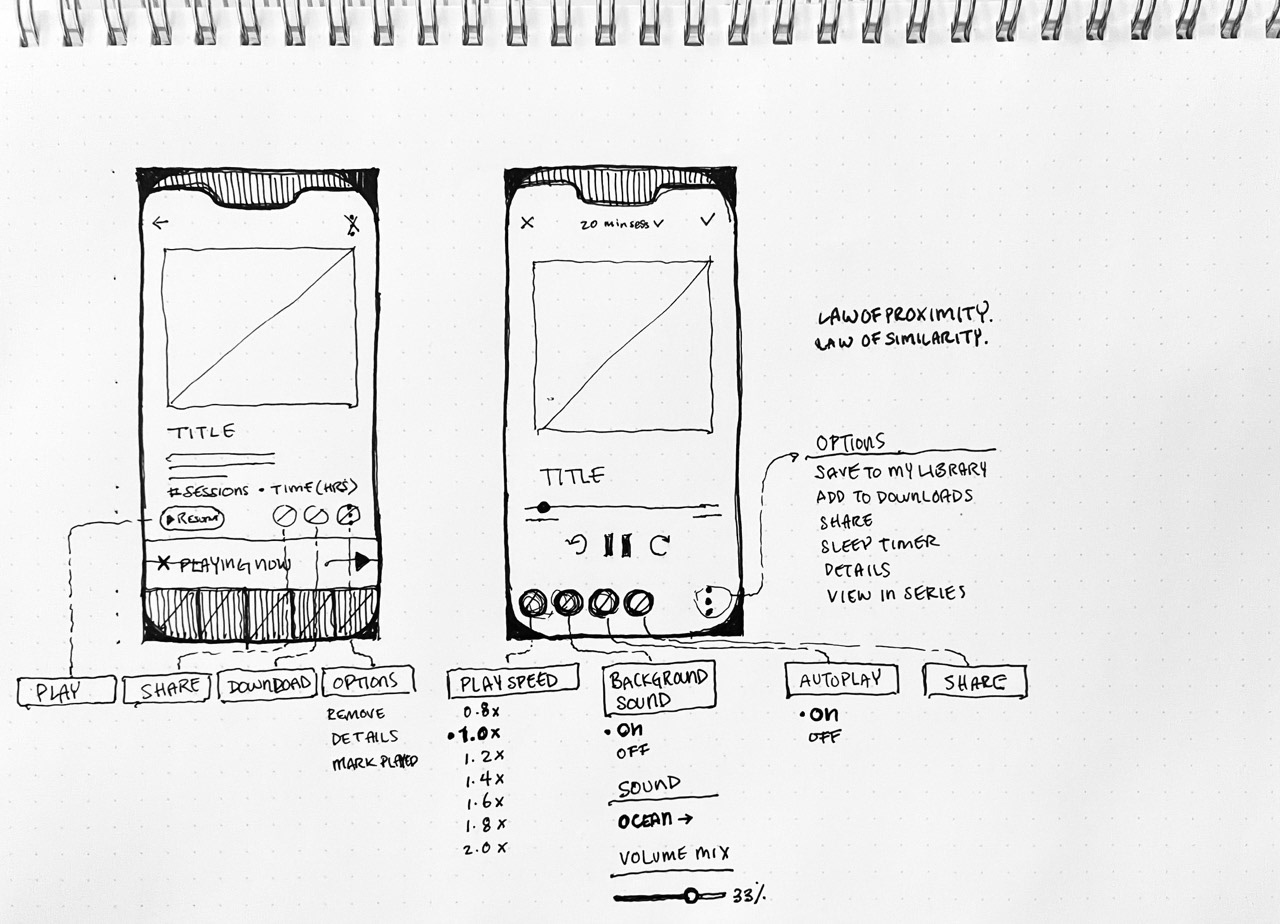Role: UX Researcher, UX/UI designer
Processes: discovery research, problem-solving, ideation,
information architecture, priority matrix, solutions matrix,
wireframing, mobile flow
information architecture, priority matrix, solutions matrix,
wireframing, mobile flow
background
This case study explores a 2021 UX redesign of the Waking Up meditation app. As a long-time user (since 2018), I aimed to improve the app's accessibility, impact, and appeal for younger generations.
My passion for the Waking Up app began in 2018. Sam Harris's lectures and books sparked my interest in meditation. After a personal loss, he dedicated himself to the practice, eventually earning a Ph.D. in cognitive neuroscience. Today, as a Waking Up user, I continue to find his work insightful and the app a valuable tool for mental wellbeing.
Problem
Existing Waking Up users struggle to maintain a consistent meditation practice due to a lack of understanding about the long-term benefits. While they experience short-term improvements, they question the overall impact, hindering their motivation to continue.
Discover
Define
Ideate
Synthesize
DISCOVERY RESEARCH
What are all the things that I'd need to answer in order to find an opportunity for this product? Am I biased upon any underlying assumptions?
Research Strategy:
[1-on-1 Interviews]: Interviewed existing Waking Up users, competitor app users, and former meditators to understand their goals, motivations, and pain points.
[Competitor Analysis]: Analyzed mindfulness and EdTech competitors to identify strengths and weaknesses, particularly regarding user engagement strategies.
[Desk Research]: Reviewed user reviews, forum discussions, and Sam Harris's work to understand users' perceptions of meditation's "why."
{TL:DR}
[Key Findings from research]
Users are not interested in gamified goal tracking (time spent meditating).
Users seek qualitative benefits for their lives, not just feeling good.
Younger demographics are drawn to aesthetically pleasing interfaces.
Users value content diversity and the ability to follow specific instructors.
[Opportunities]
De-emphasize goal quantification and highlight qualitative benefits.
structure content strategy parallel to self-development and life improvements.
Create a visually engaging user interface that users keep coming back to.
Primary Research: 1-1 Interviews
The goal here was to understand current mindfulness app users and gather qualitative data on their in-app goals, motivations, and habits.
Ideal candidate requirements:
1. Existing Waking Up Users
2. Existing users of competitor apps
(e.g. Calm, Headspace)
3. People who have meditated in the past but are no longer users
1. Existing Waking Up Users
2. Existing users of competitor apps
(e.g. Calm, Headspace)
3. People who have meditated in the past but are no longer users
Takeaway
80% of users said the ambient sound feature is always active during their practice because it adds to the listening experience and induce sleep.
70% of users reported setting practice goals does not increase their motivations. 30% of those users shrugged daily reminders were not helpful.
50% of users said Timer is their least-used feature.
When asked “Why do you meditate or what is the goal you are trying to achieve through meditation?”:
Opportunities
Users report little interest in quantifying goals in terms of accumulated time during practice. When defining their goals for meditation, participants’ answers were about improving the quality of their life by improving their state of mood or mind.
Refrain from gamifying or quantifying goals but instead to emphasize the benefits meditation can bring to the qualitative experience of living their lives.
Offer options for background sounds and sleep timer. (i.e. sleep, focus)
Competitor Analysis
to understand strengths and weaknesses of competitors in wellness & edtech sectors, and discover opportunities for implementation.
Takeaway
Mindfulness apps that focus on delightful user interface and dynamic listening experience attract younger demographic of users.
Edtech apps allows users to bookmark lessons and build their own library. Visual indicators are also used to inform users of their progress toward completing their course.
(In 2020) Waking Up apps subscription fee est. to be $140, nearly twice as much as competitor’s cost.
Waking Up app’s has diverse and high-quality content from various traditions and well-known public figures.
Opportunity
Waking Up app may capture younger audiences by providing more dynamic and visually engaging user interface.
May benefit from matching competitors by offering control over background sound preferences.
Waking Up may improve content engagement and likelihood of course completion by providing users with visual cues of their course progress. (re: goal-gradient effect; the tendency to approach a goal increases with proximity to the goal)
May also benefit user’s learning retention by giving them option to bookmark sessions and create a library of saved content.
Desk Research
I continued secondary research to understand current users reviews of Waking Up, forum discussions, Sam Harris’s recent discussions on meditation, and discover opportunities for implementation.
“Truly learning to meditate is not like going to the gym and putting on some muscle because it’s good for you and makes you feel better. There’s more to it than that. Meditation—again, done correctly—puts into question more or less everything you tend to do in your search for happiness. But if you lose sight of this, it can become just another strategy for seeking happiness—a more refined version of the problem you already have.”
Taming the Mind: A conversation between Dan Harris and Sam Harris
“In theory, there is no difference between theory and practice. In practice, there is.”
joke from Design of Everyday Things by Don Norman
Takeaway
Users of the Waking Up app have grown to understand what meditation is, how to meditate purposefully, and why it matters to us. In every instance of discussion, the ‘why’ we meditate is inextricably linked to our goals of living an examined and fulfilled life.
Opportunity
(the ‘what’, ‘how’, and ‘why’ we should meditate)
1. Theory Section (existing) discusses ‘what’ meditation is by contextualizing it through logic.
2. Practice Section (existing) hosts guided meditations where the speaker talks users through ‘how’ to examine their minds during practice.
3. A new section that helps users understand ‘why’ it matters by repurposing content from theory, practice, podcast from Making Sense, and other media that contributes to the fundamental human goal of living a good life.
Maslow's Hierarchy of Needs categorizes human needs in a pyramid structure, with basic physiological needs at the foundation and self-actualization needs at the peak. By introducing the "Life" section, you're addressing needs at multiple levels in the hierarchy, making meditation a more holistic and impactful practice for users.
Connecting Meditation Theory to Real-Life Applications (Life Section)
Esteem Needs: The "Life" section can help users achieve feelings of accomplishment and self-worth. By understanding how meditation translates into improved focus, reduced stress, and better emotional regulation, users can feel empowered to tackle challenges and reach their full potential.
Love and Belonging Needs: The section can foster a sense of connection by demonstrating how meditation can improve relationships with oneself and others. Users might find it easier to manage conflict, practice empathy, and build stronger bonds.
Safety and Security Needs: Meditation's ability to reduce anxiety and improve sleep quality addresses safety and security needs. The "Life" section can highlight these benefits, encouraging users to view meditation as a tool for managing stress and promoting overall well-being.
How the "Life" Section Applies Each Level
Content Examples:
Esteem: Articles or videos on how meditation can improve focus and decision-making skills.
Love & Belonging: Guided meditations focused on fostering compassion and understanding towards oneself and others.
Safety: How meditation can reduce anxiety and improve sleep quality, promoting a sense of security.
Connecting Theory to Practice:
The "Life" section can bridge the gap between meditation theory and its practical applications in daily life. This can help users understand how meditation contributes to their overall well-being, not just during meditation sessions.
By addressing needs across multiple levels of Maslow's Hierarchy, the "Life" section strengthens the app's value proposition. It doesn't just offer meditation exercises; it provides users with tools to improve their lives in a holistic way. This can lead to increased user engagement and a deeper understanding of the benefits of meditation.
Define
User Persona
From the research findings, I generated a persona that captures the general goals, motivations, frustrations, and habits of the target audience. I focused more on psychographics to really understand users' attitudes and aspirations.
Problem Statement
Mindfulness app users experience short-term benefits of meditation but find it hard to sustain habits because question the benefits and impacts of practice, preventing them from investing the time and energy necessary for improvement.
Ideation
POV/HMW Statements
From the persona lens, I generated POV statement that aligned with my persona goals, motivations, and frustrations. I turned each statement into ‘How Might We’ problems to generate solutions that align with each of these main problems.
Prioritization Matrix
I visually sorted the solutions according to its IMPACT vs. EFFORT
From highest to lowest priority:
From highest to lowest priority:
1. Include
2. Debate
3. Revisit
2. Debate
3. Revisit
Synthesize
Solutions Matrix
I needed to validate ideas through a matrix that
1. align findings from discovery ⤑ ideation
2. uncover any overlapping or redundant features
3. and rank according to priority.
1. align findings from discovery ⤑ ideation
2. uncover any overlapping or redundant features
3. and rank according to priority.
HMW statements,
feature name,
description,
impact/value,
justification,
supporting research
feature name,
description,
impact/value,
justification,
supporting research
Problem Statement:
Mindfulness app users experience short-term benefits of meditation but find it hard to sustain habits because question the benefits and impacts of practice, preventing them from investing the time and energy necessary for improvement.
Key Solutions
How might we emphasize the relationship between theory and practice as it relates to life?
Introduce a new section that frames the connection of theory to practice, called ‘Life’.
Introduce a new section that frames the connection of theory to practice, called ‘Life’.
How might we keep track of users’ personal data and progress from practice over time?
Display
[1] Total # of Sessions in the course
[2] Progress Bar course indicator
Display
[1] Total # of Sessions in the course
[2] Progress Bar course indicator
How might we tailor content/ style/ sounds/ features to accommodate the preferences for novice ⤑ expert users over time?
Redesign player UI for:
[1] Background Sound Option
[2] Volume Mix
[3] Autoplay
[4] Sleep Timer
[5] Bookmark Session (‘My Library’)
[6] preserved from previous settings
Redesign player UI for:
[1] Background Sound Option
[2] Volume Mix
[3] Autoplay
[4] Sleep Timer
[5] Bookmark Session (‘My Library’)
[6] preserved from previous settings
Evaluation Heuristics
Evaluation heuristics was used to identify areas for improvement during implementation, focusing on UI design consistency, accessibility, usability, and information hierarchy.
Information Architecture: Site-map
For maximum impact and minimum intervention, I needed to understand the existing mobile structure and identify places in the information architecture to implement the key solutions Doing this can improve efficiency, consistency, and overall UI experience.
[Blue] = Existing Screens
[Red] = New Screens
[Red] = New Screens
Wireframe Sketches
Sketching out the main screens impacted by solving for key solutions. While sketching, I focused on applying UX laws, heuristics, and visual principles best for accessible, navigable, easy UI.
1. Law of Proximity
2. Law of Similarity
3. Goal-gradient Effect
2. Law of Similarity
3. Goal-gradient Effect



Mobile Flow
To synthesize key solutions back to ⤑ HMW questions within the context of user flow.
Usability Heuristics:
1. User Control
2. Informative Feedback
3. Match Consistency in Real World
4. Context
5. Comfort
1. User Control
2. Informative Feedback
3. Match Consistency in Real World
4. Context
5. Comfort
Next Steps
Create wireframes to visualize the proposed solutions.
Conduct user testing to gather feedback on the redesigned features.
Implement the revised design into the Waking Up app.








